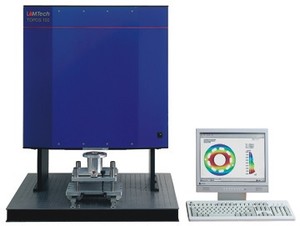Interferometer Flatness Measuring
Featured Product from Precision Surfacing Solutions

The Lapmaster/LAMTech TOPOS and SPI series of Interferometers both feature Grazing Incidence flatness inspection and the measurement capability for grinding, lapping and polishing applications. Reflective surfaces, matte surfaces and ground surfaces can all be optically measured.
The compact and cost-effective SPI series (Models #75 & #130) are contact flatness measuring gauging systems and utilize grazing incidence interferometry, providing the capability to measure surface flatness of non-reflective, as well as reflective surfaces. A black & white monitor is included with these systems. A valuable optional accessory is a computer interface package consisting primarily of a frame-grabber card and proprietary software. With this system, the SPI unit can be hooked-up to a desk-top PC so that the flatness image generated can be saved (bmp format), as well as printed to a conventional printer. These systems are quite accurate, easy to read and provide a fast qualitative or quantitative evaluation. Due to the compact design and ergonomic configuration, these systems are quite portable. They make excellent close-proximity flatness measuring tools in a manufacturing environment.
The TOPOS series (Models #50 & #100) of non-contact flatness measuring gauging systems utilizing grazing incidence laser interferometry. This provides the capability to measure surface flatness of non-reflective, as well as reflective surfaces, all in 1 unit!
On both TOPOS systems, the system sensitivity can be selected from four calibrated settings of 0.5, 1, 2 and 4 micron/fringe. On the model #100, these sensitivity value settings can be selected from the software interface and any changes selected automatically take place within the unit, via a servo drive (this is particularly useful when switching from highly reflective to dull or matte surfaces). Another unique & flexible feature to the TOPOS 100 system is the laser/camera interface which incorporates a "zoom" feature, allowing for a greater magnification of smaller diameter parts, providing a greater number of datum measurement points applied to the surface.
An air gap between the prism and the part being checked means maximum protection of the mechanism and facilitates ease of handling. As no laser or optical components contact the work-piece, there is no need for concern regarding any contaminants (dust or other debris) between the target part and the system, which ensures a more accurate reading (enhanced statistical capability). This "upper vertical" laser arrangement allows for optional high-speed automation and other parts handling systems… We also offer optional enclosures to protect against adverse ambient conditions such as dust, debris or coolant mist.
The proprietary computer-based flatness evaluation provides for a three dimensional overview, which is fast, accurate and objective. This system is intuitive and allows for a rapid change between various part configurations regardless of diameter, surface reflectivity (or lack of) or part thickness. To reduce operator intervention (and save time) measurement menus can be saved and quickly called-up for specific parts. All measurements can be saved and/or printed-out (printer optional) at a later time. Data can be exported to QC programs-statistics in a CSV data format, in qs-STAT data format or via serial interface.




